Indoor Playground Business Plan for Starting Your Own Business
Do you want to open up a child recreational center such as an indoor playground? Providing an opportunity for children to play and grow in a healthy and safe environment is no doubt a business which being profitable is interesting too. Though the business doesn’t require any specific knowledge or skillset, however, the importance of having good management skills can’t be disregarded. If you think you responsible enough to run a challenging business like this, you must start making your kids indoor playground business plan. To help you we are providing here a sample business plan indoor playground for a child recreational center startup named, PlayLand.
Executive Summary
2.1 The Business
PlayLand will be a modern indoor center for children to enjoy different activities. The center will be based in Dallas and will be owned by a lady, Kate Dench. PlayLand will be providing several opportunities to children and teens to enhance their mental and physical capability under the supervision of highly trained staff.
2.2 Management of Indoor Playground
Managing a child playing center is no doubt a time-consuming job, that’s why Kate has decided to hire a general manager to help her in running the business. Following a stepwise approach, she has decided to make a business plan first before jumping in the preparations. Though many business plans for indoor playgrounds are available on the web, Kate will seek the services of experts to help her in making a modern indoor playground business plan.
2.3 Customers of Indoor Playground
Instead of thinking about how to start indoor playground business, researching on who will be your customers can be a much better idea. Knowing your customers can help you in deciding many things related to your startup such as your services, your product pricing, and your advertisement strategy for business plan. As for PlayLand, the customers will mostly be the parents. But, since the center will be providing some games for teens too, we expect that some youngsters will also be coming to our place.
2.4 Business Target
Defining targets can help one in thriving in the business area with even more enthusiasm. In this sample spreadsheet for indoor playground business plan we are mentioning a few business targets of PlayLand. The center aims at balancing the startup costs with the profits earned by the end of the two years of the launch while earning a profit margin of $10k per month by the end of the startup year.
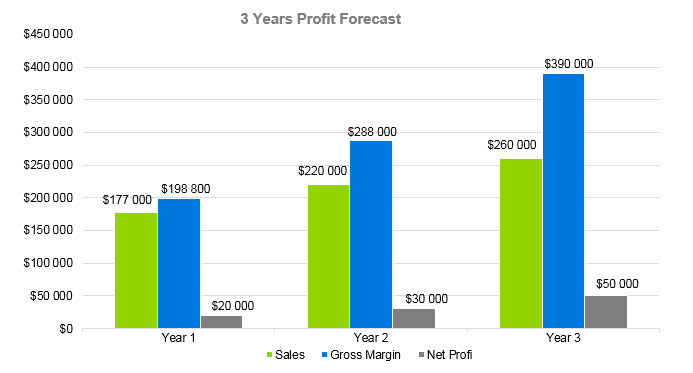
Company Summary
3.1 Company Owner
Kate Dench will be the owner of PlayLand. Kate has done bachelors in Sociology from Stanford University and has been teaching in a high school for a year. Kate is a hardworking person and strongly believes that loyalty with the customers and work is the only way that can lead her business to the topmost position.
3.2 Why the indoor playground business is being started
Kate wanted to secure her future by investing her money in establishing a business that can benefit her for a long time. So, following her graduation, she thought upon all her interests and decided to start an indoor playground business. She has several ideas about how to make a kids play area that’s why she can do this in a much better way than anybody else.
3.3 How the indoor playground business will be started
Following a stepwise approach, Kate has decided to hire a business plan writer to make a business plan for her. She has already rented a building with 4 rooms and a large lounge along with a playing field. Now, she will have to convert it in a modern indoor play area by installing different games and playthings.
Kate wants to get each and everything settled on time that’s why she has started to invest her several hours on work from now. She has even contacted the store owners from whom she will be purchasing the required equipment. Kate will also be hiring the required staff one week before the launch. In this sample business plan on how to start indoor playground business, we’ll later be listing the exact number of employees with their job descriptions.
The costs for of startup are as follows:
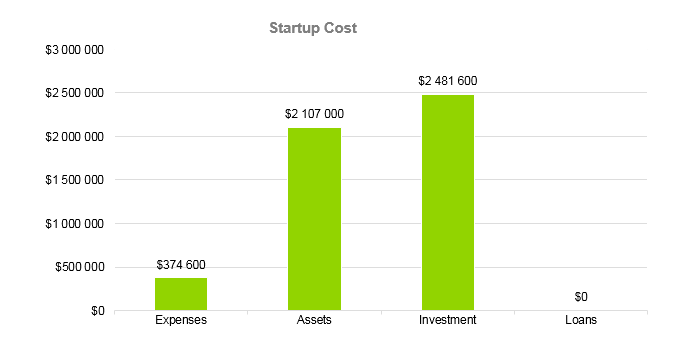
The startup requirements are as follows:
| Start-up Expenses | ||
| Legal | $110 600 | |
| Consultants | $0 | |
| Insurance | $65 500 | |
| Rent | $65 000 | |
| Research and Development | $65 500 | |
| Expensed Equipment | $65 500 | |
| Signs | $2 500 | |
| TOTAL START-UP EXPENSES | $374 600 | |
| Start-up Assets | $441 750 | |
| Cash Required | $665 000 | |
| Start-up Inventory | $65 250 | |
| Other Current Assets | $465 000 | |
| Long-term Assets | $470 000 | |
| TOTAL ASSETS | $2 107 000 | |
| Total Requirements | $2 481 600 | |
| START-UP FUNDING | ||
| Start-up Expenses to Fund | $374 600 | |
| Start-up Assets to Fund | $2 107 000 | |
| TOTAL FUNDING REQUIRED | $2 481 600 | |
| Assets | ||
| Non-cash Assets from Start-up | $911 750 | |
| Cash Requirements from Start-up | $665 000 | |
| Additional Cash Raised | $37 500 | |
| Cash Balance on Starting Date | $43 750 | |
| TOTAL ASSETS | $1 658 000 | |
| Liabilities and Capital | ||
| Liabilities | $34 000 | |
| Current Borrowing | $0 | |
| Long-term Liabilities | $0 | |
| Accounts Payable (Outstanding Bills) | $50 000 | |
| Other Current Liabilities (interest-free) | $0 | |
| TOTAL LIABILITIES | $84 000 | |
| Capital | ||
| Planned Investment | $2 481 600 | |
| Investor 1 | $0 | |
| Investor 2 | $0 | |
| Other | $0 | |
| Additional Investment Requirement | $0 | |
| TOTAL PLANNED INVESTMENT | $2 481 600 | |
| Loss at Start-up (Start-up Expenses) | ($907 600) | |
| TOTAL CAPITAL | $1 574 000 | |
| TOTAL CAPITAL AND LIABILITIES | $1 658 000 | |
| Total Funding | $2 481 600 | |
Services for Customers
If you are thinking about how to open a kids indoor playground, you must first decide which services you will be able to provide. Because if you don’t have enough capital to support basic activities in your playhouse, you won’t be able to earn a big name. So, before starting your own childrens indoor playhouse, it is wise to think whether you can provide the desired services or not.
Though Kate is not starting her business at a very large scale, she has decided to provide the following services:
- Active Play: There will be playrooms for children of ages 3 to 10. The rooms will be beautifully decorated and will contain various toys, books and things like tricycles to be used by the children.
- Art Classes: Children will be provided simple art classes in which they could enjoy music, learn to sing and dance, learn drawing, learn to paint and enjoy playing the musical instruments.
- Craft Hour: In craft hour children will be asked to complete a given project such as weaving a butterfly. This class will serve for two purposes – to engage children in a healthy activity and to enhance their creativity.
- Group Activities: Under strict supervision, children will be given a chance to enjoy group activities such as racing tricycles, playing carrom board, playing badminton or play on the see-saw with each other.
- Activities for Teens: Teens will be allowed to play table tennis and badminton in the center. Moreover, they will be given a well-decorated area to celebrate their birthdays or to hold any parties.
- Eatables: There will be a snack bar from where the children could get sandwiches, snacks, juices, and tea.
Business Plan for Investors
Marketing Analysis of Indoor Playground Business
Before taking an indoor playground startup, you must search for a market which has the potential to bear this type of startup. Exploring different markets before starting your business is essential because no one will acquire your services if they have already been availing the services of a similar and more stable business. So, it is very important to carry out a research on the market in which you will be going to serve. Reading several business plans for indoor playground can help you in knowing about different markets as well as to know what others are doing in this business.
In the case of PlayLand, Kate has leased a building which has almost no other child recreational center in the vicinity, so she can attract a wider audience easily.
Operational/Strategic Planning Services
5.1 Market Trends
The indoor playgrounds have a high demand at the places where the population of children is high. If you are selecting the location for your business wisely, you will not be at loss as opening a child recreational center provides many opportunities to grow.
5.2 Marketing Segmentation
Knowing your customers and their demands is the first step to take if you want to succeed in any domain. The market segmentation done for PlayLand is general and is given here for anyone who wants to get a notion of which sort of people they will have to face.
The detailed marketing segmentation of our target audience is as follows:
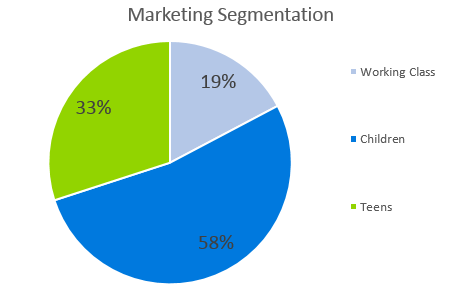
5.2.1 Working Class
The first group of our customers will be the parents who have to go to their jobs or have to do certain works in the evening. We are sure that the parents if getting satisfied with our performance, will come to us again and again. And we expect their children to say themselves that they want to stay with us and play and enjoy with their age-mates.
5.2.2 Children of ages 10-14
The children of this age group will also be our target customers as they will be coming to us to play physical and mental games with their friends. They will also be availing our services to held parties.
5.2.3 Teens
The last category includes teens who will come to our center either with a sibling or to celebrate some event with their friends. We will soon be providing more physical activities for teens so that they have very much tasks awaiting them in PlayLand.
| Market Analysis | |||||||
| Potential Customers | Growth | Year 1 | Year 2 | Year 3 | Year 4 | Year 5 | CAGR |
| Working Class | 19% | 22 866 | 26 688 | 33 106 | 37 490 | 41 090 | 10% |
| Children | 58% | 44 668 | 64 688 | 87 330 | 105 088 | 132 864 | 10% |
| Teens | 33% | 25 734 | 28 866 | 31 998 | 35 130 | 38 262 | 10% |
| Total | 100% | 93 268 | 120 242 | 152 434 | 177 708 | 212 216 | 10% |
5.3 Business Target
Kate’s target is to make her indoor PlayLand, the best playground in her vicinity. While providing reliable and honest service, Kate wants to set up her business and all matters in the first year so that she can move forward to make her children play center’s name a brand name. She also wants to add activities for children by the end of the first year. And she also aims at renting out a neighboring building to provide a similar facility for teens who will need a greater space and proper ground to enjoy themselves.
The financial targets, however, are as follows:
- Balancing startup costs and investments within the first year of launch
- Earning a profit margin of $10k by the end of the second year and increasing the profit margin by almost 200 percent by the end of the third year
5.4 Product Pricing
The prices of PlayLand will neither be very low nor too high. Kate has decided to take reasonable charges in exchange for her services because she thought that if one has to compromise on money – one will automatically be compromising somewhere on quality. As Kate has a great competitive aspect due to her location, she doesn’t need to keep her prices low to attract the customers.
Strategy
After you have explored various indoor playground business ideas and have succeeded in planning and creating play spaces, you have almost done what was required to start your indoor playhouse. Now the next step is a little difficult and includes the implementation of wise techniques to bring your customers to your doorstep. In this business development plan for an indoor playground, the ways adopted by Kate to be different and popular are given here.
6.1 Competitive Analysis
PlayLand will be just one of its type in the neighboring vicinity, which makes it easier for us to attract the target customers. Our biggest competitive advantage is our reliable service. We will be treating your kids like our kids. We will offer just physical games because parents usually don’t want their kids to associate their enjoyment with television and the internet. Moreover, children will be under a kind but strict supervision, and they will never get a chance to fight or quarrel with each other.
High Quality Business Plan and Professional Support
It was amazing to work with OGS Capital for our business plan. They promptly responded our enquires and delivered document on time.The document was well organized high quality and content.We succeded with Alex and his team support. We thank you guys again for professional approach and easy communication.
Lastly, we will be having exceptional customer service, Kate herself will be interacting and coordinating with parents to satisfy them that their kids are treated under love and care.
6.2 Sales Strategy
To advertise our services, we will:
- Share the pictures of our services on our center’s website and social sites
- Distribute our pamphlets in our neighboring areas
- Provide 20% discount for the first month of our launch
- Provide 15% discount to our regular customers
- Provide free eatables to children for the first week of our launch
6.3 Sales Monthly
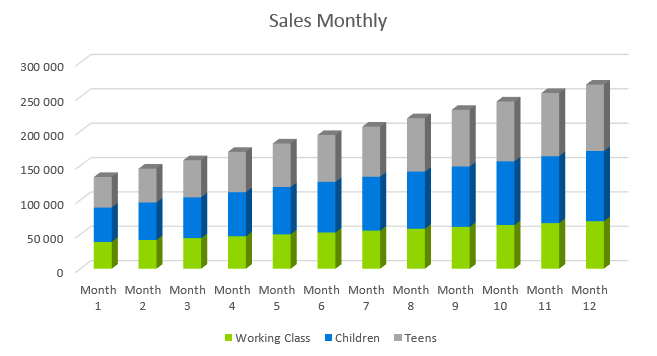
6.4 Sales Yearly
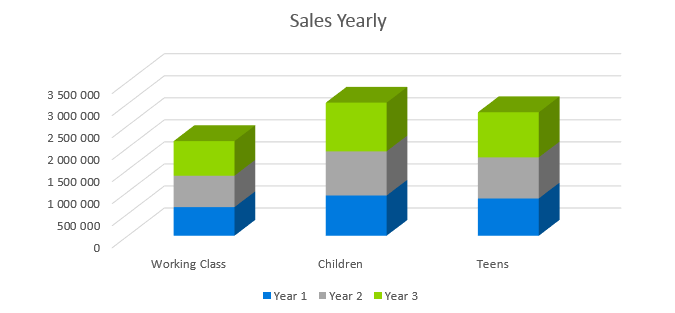
6.5 Sales Forecast
Our sales are forecasted in the following column charts:
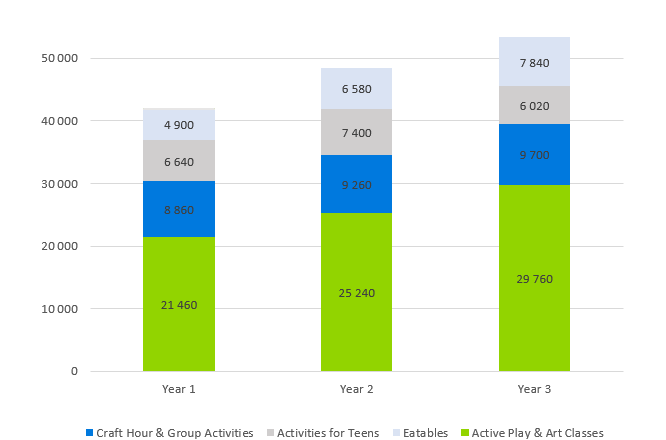
The detailed information about the sales forecast is given in the following table:
| Sales Forecast | |||
| Unit Sales | Year 1 | Year 2 | Year 3 |
| Active Play & Art Classes | 21 460 | 25 240 | 29 760 |
| Craft Hour & Group Activities | 8 860 | 9 260 | 9 700 |
| Activities for Teens | 6 640 | 7 400 | 6 020 |
| Eatables | 4 900 | 6 580 | 7 840 |
| TOTAL UNIT SALES | 41 860 | 48 480 | 53 320 |
| Unit Prices | Year 1 | Year 2 | Year 3 |
| Active Play & Art Classes | $40,00 | $40,00 | $40,00 |
| Craft Hour & Group Activities | $49,00 | $49,00 | $49,00 |
| Activities for Teens | $60,00 | $60,00 | $60,00 |
| Eatables | $73,00 | $73,00 | $73,00 |
| Sales | |||
| Active Play & Art Classes | $858 400,00 | $1 009 600,00 | $1 190 400,00 |
| Craft Hour & Group Activities | $434 140,00 | $453 740,00 | $475 300,00 |
| Activities for Teens | $398 400,00 | $444 000,00 | $361 200,00 |
| Eatables | $357 700,00 | $480 340,00 | $572 320,00 |
| TOTAL SALES | $2 048 640,00 | $2 387 680,00 | $2 599 220,00 |
| Direct Unit Costs | Year 1 | Year 2 | Year 3 |
| Active Play & Art Classes | $30,00 | $30,00 | $30,00 |
| Craft Hour & Group Activities | $36,75 | $36,75 | $36,75 |
| Activities for Teens | $45,00 | $45,00 | $45,00 |
| Eatables | $54,75 | $54,75 | $54,75 |
| Direct Cost of Sales | |||
| Active Play & Art Classes | $643 800,00 | $757 200,00 | $892 800,00 |
| Craft Hour & Group Activities | $325 605,00 | $340 305,00 | $356 475,00 |
| Activities for Teens | $298 800,00 | $333 000,00 | $270 900,00 |
| Eatables | $268 275,00 | $360 255,00 | $429 240,00 |
| Subtotal Direct Cost of Sales | $1 536 480,00 | $1 790 760,00 | $1 949 415,00 |
Note
If you are planning to open an indoor baby play area but are worried about the costs of playroom equipment, be at ease.
Personnel plan
As child recreational center is a sort of business which can be started without a huge investment, you can start it with limited indoor playground equipment. You will require children soft play equipment as the kids of ages between 3 to 7 are more inclined towards gaming with soft indoor play equipment.
However, for teens and for children of the age group 8 to 12, you will have to buy somewhat sports material like rackets, balls and an indoor playground net.
7.1 Company Staff
To meet the standards, Kate has set for her business, she herself will be coordinating with the parents. However, she will be hiring the following people for other tasks:
- 1 General Manager to manage the overall operations
- 2 Accountants to maintain financial records
- 1 Sales Executive responsible for marketing
- 5 Female Workers to supervise the children
- 2 Cleaners to ensure a hygienic environment
- 1 General Assistant for day-to-day work
- 1 Manager to operate the store
- 2 Security Guards
- 1 Web Developer to manage the center’s websites
7.2 Average Salary of Employees
| Personnel Plan | |||
| Year 1 | Year 2 | Year 3 | |
| General Manager | $40 000 | $44 000 | $48 400 |
| Accountants | $25 000 | $27 500 | $30 250 |
| Sales Executives | $30 000 | $33 000 | $36 300 |
| Female Workers | $20 000 | $22 000 | $24 200 |
| Cleaners | $15 000 | $16 500 | $18 150 |
| General Assistant | $20 000 | $22 000 | $24 200 |
| Manager | $35 000 | $38 500 | $42 350 |
| Security Guards | $25 000 | $27 500 | $30 250 |
| Web Developer | $50 000 | $55 000 | $60 500 |
| Total Salaries | $260 000 | $286 000 | $314 600 |
Financial Plan
The last thing which you must have to do is to get written a proper financial plan that can demonstrate how much do playgrounds cost and how you will be able to afford that. If you are worried about how much does playground equipment cost or how much do indoor playgrounds make, just seek help from a financial advisor. A financial expert can help you figure out where to invest and how to earn a profit despite providing discounts and packages to the customers. A financial expert also provides you a plan to recover loss if you somehow get your business stuck in a crisis or if you are failed in making desired profits.
In case, you have a little know-how of a financial plan and you want to make it by yourself, you must first read other’s business plans available on the web. The <strong>sample startup budget for child care center<strong> and a recreational lot that is PlayLand is given here totally free for your help.
8.1 Important Assumptions
| General Assumptions | |||
| Year 1 | Year 2 | Year 3 | |
| Plan Month | 1 | 2 | 3 |
| Current Interest Rate | 10,00% | 11,00% | 12,00% |
| Long-term Interest Rate | 10,00% | 10,00% | 10,00% |
| Tax Rate | 26,42% | 27,76% | 28,12% |
| Other | 0 | 0 | 0 |
8.2 Brake-even Analysis
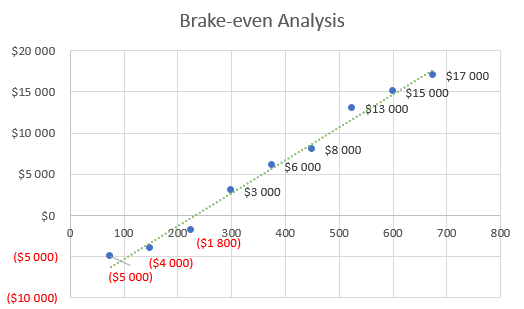
| Brake-Even Analysis | ||
| Monthly Units Break-even | 5530 | |
| Monthly Revenue Break-even | $159 740 | |
| Assumptions: | ||
| Average Per-Unit Revenue | $260,87 | |
| Average Per-Unit Variable Cost | $0,89 | |
| Estimated Monthly Fixed Cost | $196 410 | |
8.3 Projected Profit and Loss
| Pro Forma Profit And Loss | |||
| Year 1 | Year 2 | Year 3 | |
| Sales | $2 048 640 | $2 387 680 | $2 599 220 |
| Direct Cost of Sales | $1 536 480 | $1 790 760 | $1 949 415 |
| Other | $0 | $0 | $0 |
| TOTAL COST OF SALES | $1 536 480 | $1 790 760 | $1 949 415 |
| Gross Margin | $512 160 | $596 920 | $649 805 |
| Gross Margin % | 25,00% | 25,00% | 25,00% |
| Expenses | |||
| Payroll | $260 000 | $286 000 | $314 600 |
| Sales and Marketing and Other Expenses | $1 850 | $2 000 | $2 150 |
| Depreciation | $2 070 | $2 070 | $2 070 |
| Leased Equipment | $0 | $0 | $0 |
| Utilities | $4 000 | $4 250 | $4 500 |
| Insurance | $1 800 | $1 800 | $1 800 |
| Rent | $6 500 | $7 000 | $7 500 |
| Payroll Taxes | $34 510 | $40 726 | $46 942 |
| Other | $0 | $0 | $0 |
| Total Operating Expenses | $310 730 | $343 846 | $379 562 |
| Profit Before Interest and Taxes | $201 430 | $253 074 | $270 243 |
| EBITDA | $201 430 | $253 074 | $270 243 |
| Interest Expense | $0 | $0 | $0 |
| Taxes Incurred | $161 144 | $202 459 | $216 194 |
| Net Profit | $40 286 | $50 615 | $54 049 |
| Net Profit/Sales | 1,97% | 2,12% | 2,08% |
8.3.1 Profit Monthly
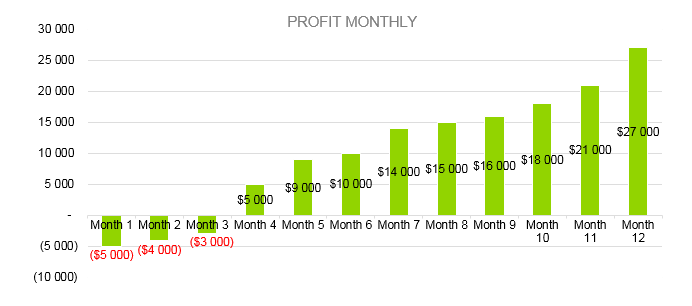
8.3.2 Profit Yearly
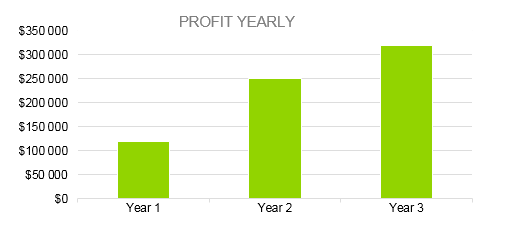
8.3.3 Gross Margin Monthly
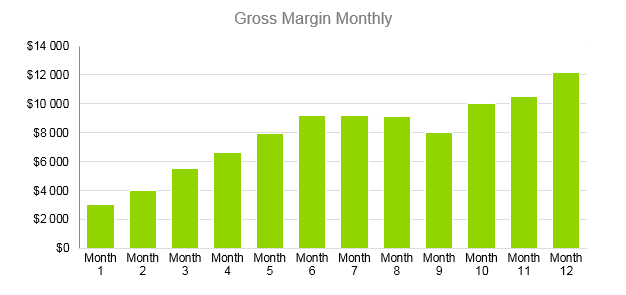
8.3.4 Gross Margin Yearly
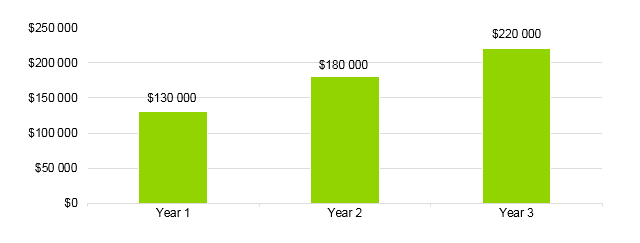
8.4 Projected Cash Flow
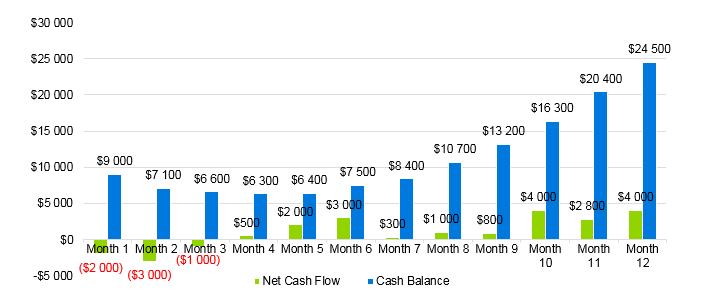
| Pro Forma Cash Flow | |||
| Cash Received | Year 1 | Year 2 | Year 3 |
| Cash from Operations | |||
| Cash Sales | $40 124 | $45 046 | $50 068 |
| Cash from Receivables | $7 023 | $8 610 | $9 297 |
| SUBTOTAL CASH FROM OPERATIONS | $47 143 | $53 651 | $59 359 |
| Additional Cash Received | |||
| Sales Tax, VAT, HST/GST Received | $0 | $0 | $0 |
| New Current Borrowing | $0 | $0 | $0 |
| New Other Liabilities (interest-free) | $0 | $0 | $0 |
| New Long-term Liabilities | $0 | $0 | $0 |
| Sales of Other Current Assets | $0 | $0 | $0 |
| Sales of Long-term Assets | $0 | $0 | $0 |
| New Investment Received | $0 | $0 | $0 |
| SUBTOTAL CASH RECEIVED | $47 143 | $53 651 | $55 359 |
| Expenditures | Year 1 | Year 2 | Year 3 |
| Expenditures from Operations | |||
| Cash Spending | $21 647 | $24 204 | $26 951 |
| Bill Payments | $13 539 | $15 385 | $170 631 |
| SUBTOTAL SPENT ON OPERATIONS | $35 296 | $39 549 | $43 582 |
| Additional Cash Spent | |||
| Sales Tax, VAT, HST/GST Paid Out | $0 | $0 | $0 |
| Principal Repayment of Current Borrowing | $0 | $0 | $0 |
| Other Liabilities Principal Repayment | $0 | $0 | $0 |
| Long-term Liabilities Principal Repayment | $0 | $0 | $0 |
| Purchase Other Current Assets | $0 | $0 | $0 |
| Purchase Long-term Assets | $0 | $0 | $0 |
| Dividends | $0 | $0 | $0 |
| SUBTOTAL CASH SPENT | $35 296 | $35 489 | $43 882 |
| Net Cash Flow | $11 551 | $13 167 | $15 683 |
| Cash Balance | $21 823 | $22 381 | $28 239 |
8.5 Projected Balance Sheet
| Pro Forma Balance Sheet | |||
| Assets | Year 1 | Year 2 | Year 3 |
| Current Assets | |||
| Cash | $184 666 | $218 525 | $252 384 |
| Accounts Receivable | $12 613 | $14 493 | $16 373 |
| Inventory | $2 980 | $3 450 | $3 920 |
| Other Current Assets | $1 000 | $1 000 | $1 000 |
| TOTAL CURRENT ASSETS | $201 259 | $237 468 | $273 677 |
| Long-term Assets | |||
| Long-term Assets | $10 000 | $10 000 | $10 000 |
| Accumulated Depreciation | $12 420 | $14 490 | $16 560 |
| TOTAL LONG-TERM ASSETS | $980 | $610 | $240 |
| TOTAL ASSETS | $198 839 | $232 978 | $267 117 |
| Liabilities and Capital | Year 1 | Year 2 | Year 3 |
| Current Liabilities | |||
| Accounts Payable | $9 482 | $10 792 | $12 102 |
| Current Borrowing | $0 | $0 | $0 |
| Other Current Liabilities | $0 | $0 | $0 |
| SUBTOTAL CURRENT LIABILITIES | $9 482 | $10 792 | $12 102 |
| Long-term Liabilities | $0 | $0 | $0 |
| TOTAL LIABILITIES | $9 482 | $10 792 | $12 102 |
| Paid-in Capital | $30 000 | $30 000 | $30 000 |
| Retained Earnings | $48 651 | $72 636 | $96 621 |
| Earnings | $100 709 | $119 555 | $138 401 |
| TOTAL CAPITAL | $189 360 | $222 190 | $255 020 |
| TOTAL LIABILITIES AND CAPITAL | $198 839 | $232 978 | $267 117 |
| Net Worth | $182 060 | $226 240 | $270 420 |
8.6 Business Ratios
| Ratio Analysis | ||||
| Year 1 | Year 2 | Year 3 | INDUSTRY PROFILE | |
| Sales Growth | 4,35% | 30,82% | 63,29% | 4,00% |
| Percent of Total Assets | ||||
| Accounts Receivable | 5,61% | 4,71% | 3,81% | 9,70% |
| Inventory | 1,85% | 1,82% | 1,79% | 9,80% |
| Other Current Assets | 1,75% | 2,02% | 2,29% | 27,40% |
| Total Current Assets | 138,53% | 150,99% | 163,45% | 54,60% |
| Long-term Assets | -9,47% | -21,01% | -32,55% | 58,40% |
| TOTAL ASSETS | 100,00% | 100,00% | 100,00% | 100,00% |
| Current Liabilities | 4,68% | 3,04% | 2,76% | 27,30% |
| Long-term Liabilities | 0,00% | 0,00% | 0,00% | 25,80% |
| Total Liabilities | 4,68% | 3,04% | 2,76% | 54,10% |
| NET WORTH | 99,32% | 101,04% | 102,76% | 44,90% |
| Percent of Sales | ||||
| Sales | 100,00% | 100,00% | 100,00% | 100,00% |
| Gross Margin | 94,18% | 93,85% | 93,52% | 0,00% |
| Selling, General & Administrative Expenses | 74,29% | 71,83% | 69,37% | 65,20% |
| Advertising Expenses | 2,06% | 1,11% | 0,28% | 1,40% |
| Profit Before Interest and Taxes | 26,47% | 29,30% | 32,13% | 2,86% |
| Main Ratios | ||||
| Current | 25,86 | 29,39 | 32,92 | 1,63 |
| Quick | 25,4 | 28,88 | 32,36 | 0,84 |
| Total Debt to Total Assets | 2,68% | 1,04% | 0,76% | 67,10% |
| Pre-tax Return on Net Worth | 66,83% | 71,26% | 75,69% | 4,40% |
| Pre-tax Return on Assets | 64,88% | 69,75% | 74,62% | 9,00% |
| Additional Ratios | Year 1 | Year 2 | Year 3 | |
| Net Profit Margin | 19,20% | 21,16% | 23,12% | N.A. |
| Return on Equity | 47,79% | 50,53% | 53,27% | N.A. |
| Activity Ratios | ||||
| Accounts Receivable Turnover | 4,56 | 4,56 | 4,56 | N.A. |
| Collection Days | 92 | 99 | 106 | N.A. |
| Inventory Turnover | 19,7 | 22,55 | 25,4 | N.A. |
| Accounts Payable Turnover | 14,17 | 14,67 | 15,17 | N.A. |
| Payment Days | 27 | 27 | 27 | N.A. |
| Total Asset Turnover | 1,84 | 1,55 | 1,26 | N.A. |
| Debt Ratios | ||||
| Debt to Net Worth | 0 | -0,02 | -0,04 | N.A. |
| Current Liab. to Liab. | 1 | 1 | 1 | N.A. |
| Liquidity Ratios | ||||
| Net Working Capital | $120 943 | $140 664 | $160 385 | N.A. |
| Interest Coverage | 0 | 0 | 0 | N.A. |
| Additional Ratios | ||||
| Assets to Sales | 0,45 | 0,48 | 0,51 | N.A. |
| Current Debt/Total Assets | 4% | 3% | 2% | N.A. |
| Acid Test | 23,66 | 27,01 | 30,36 | N.A. |
| Sales/Net Worth | 1,68 | 1,29 | 0,9 | N.A. |
| Dividend Payout | 0 | 0 | 0 | N.A. |
Download Indoor Playground Business Plan Sample in pdf
Professional writers OGS capital specialized also on the theme such as baby boutique store business plan, babysitting business strategy plan, bouncy castle business plan, professional daycare business plan, summer camp business plan model, business plan toy store and etc.





 (8 votes, average: 3.88 out of 5)
(8 votes, average: 3.88 out of 5)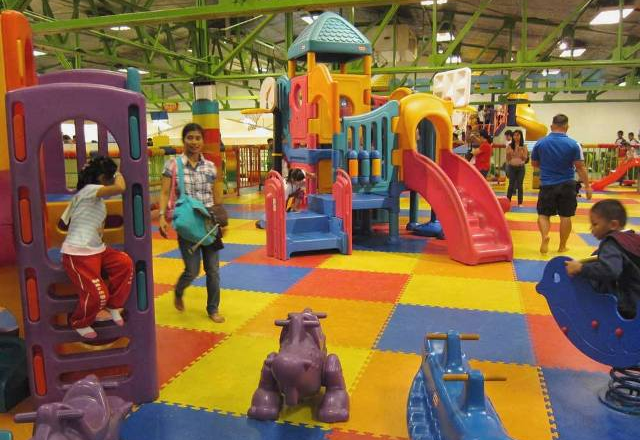


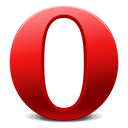
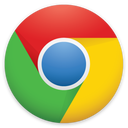

Add comment
Comments (0)